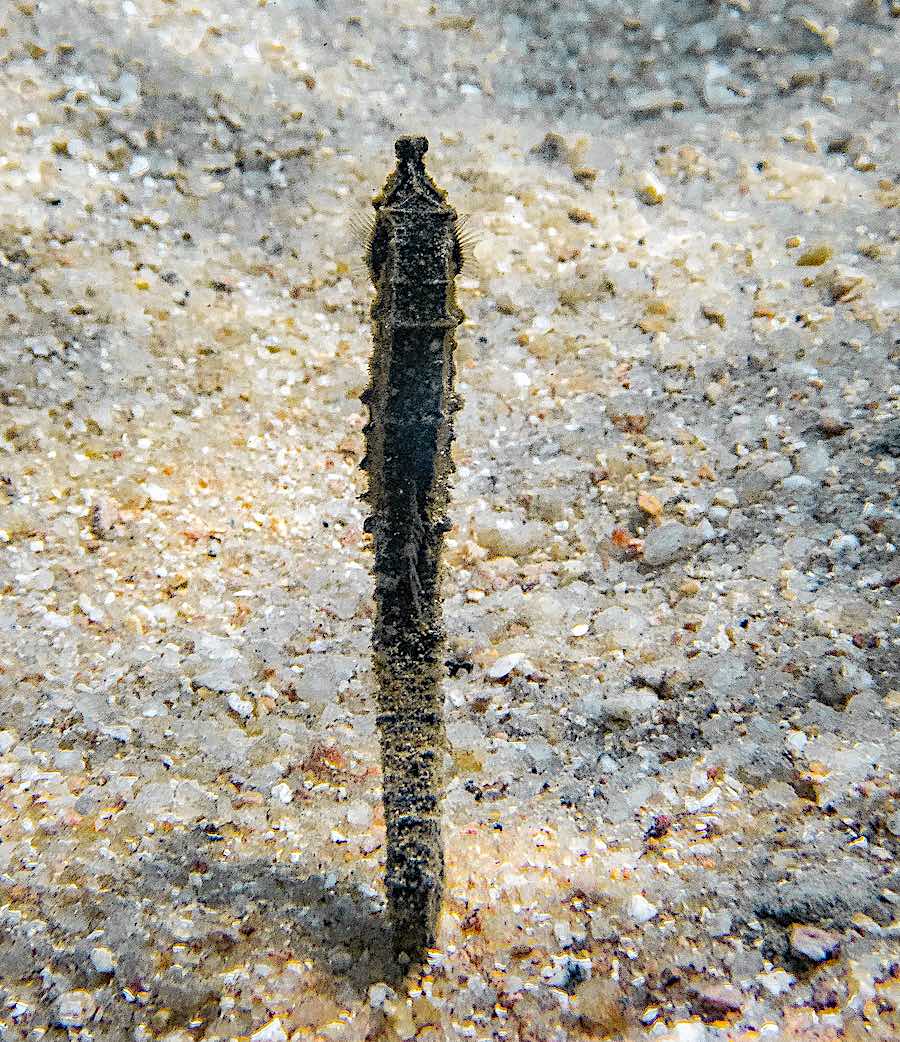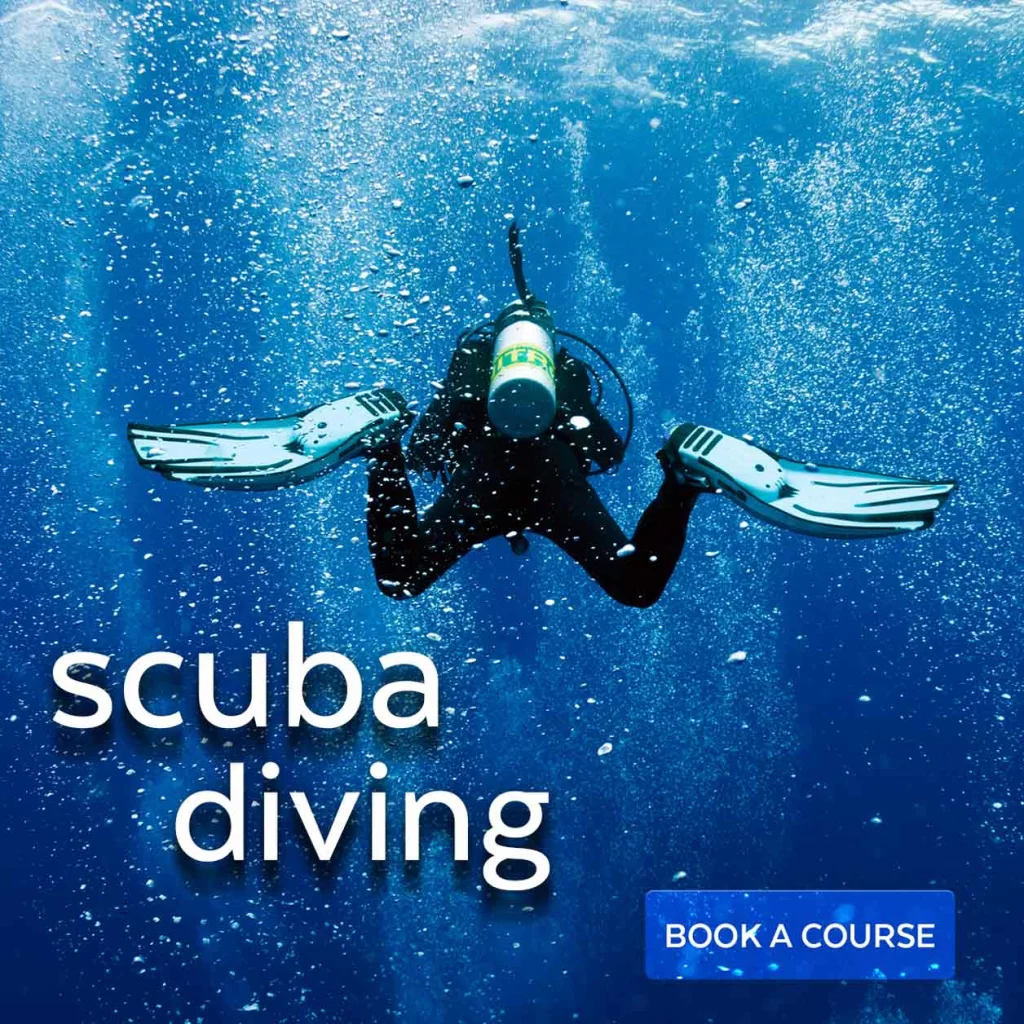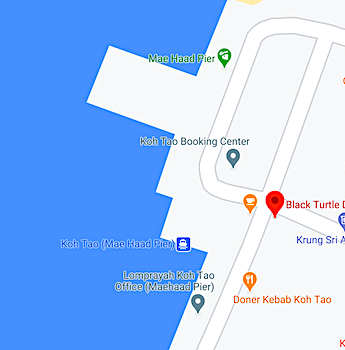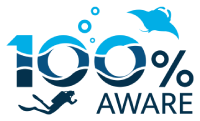Seahorse Ecology & Monitoring Course in Thailand
Seahorse Ecology Marine Conservation course in Thailand
Our Conservation Diver Seahorse specialty course introduces students to one of the most interesting, popular and endangered marine fish – Seahorses.
Loved around the world by enthusiasts and scientists alike, Seahorses have unique attributes and a critical role to play in the marine ecosystem.
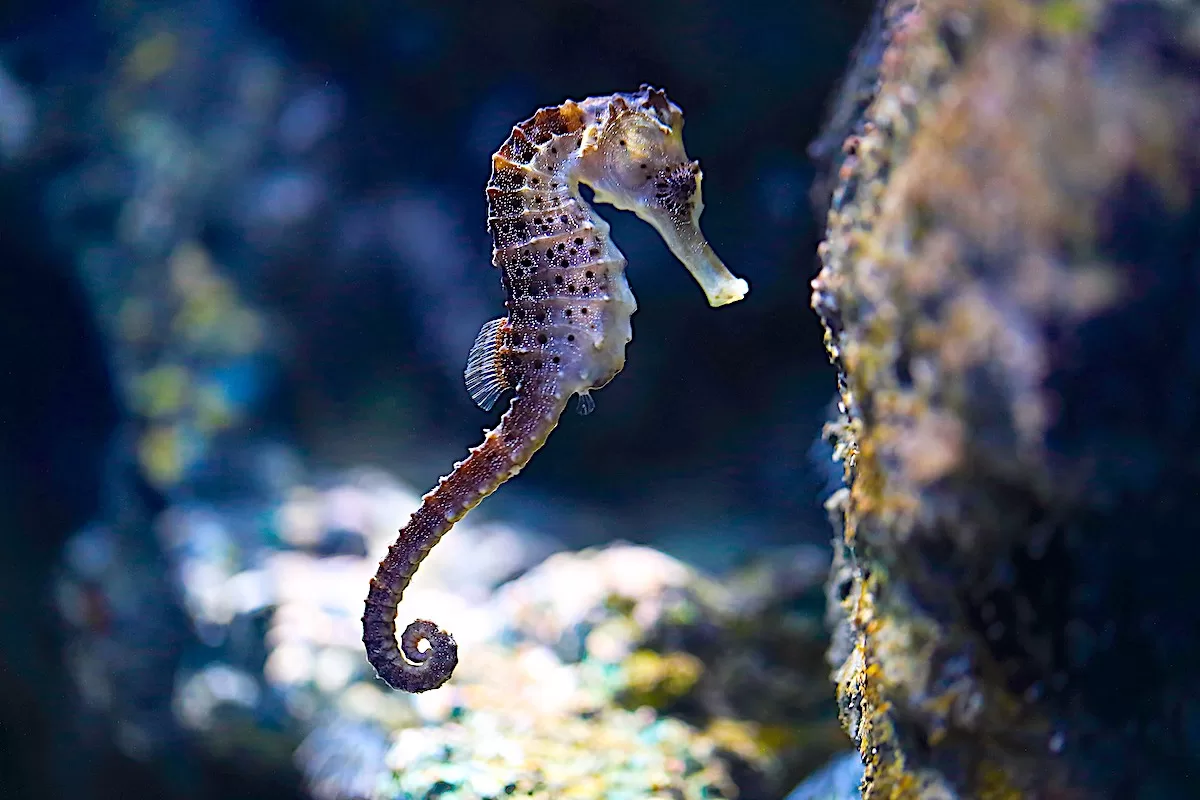
Seahorse Characteristics
Seahorses are a type of marine fish found in shallow, tropical and temperate waters and oceans around the world. Seahorses are known for their unique appearance, with a long snout and a curved, prehensile tail, which they use to anchor themselves to corals or other objects.
Seahorses have a bony exoskeleton, rather than scales, and their bodies are covered in small, bony plates that are fused together with a fleshy covering and they have a crown like structure on top of their head called a Coronet.
Seahorses are a Marine Fish
One of the most remarkable features of Seahorses is their reproductive behavior. Unlike many other fish, male seahorses carry the fertilized eggs in a special pouch on their abdomen until they hatch.
The female deposits the eggs into the male’s pouch during mating, and he fertilizes them internally before carrying them for up to several weeks until they hatch.
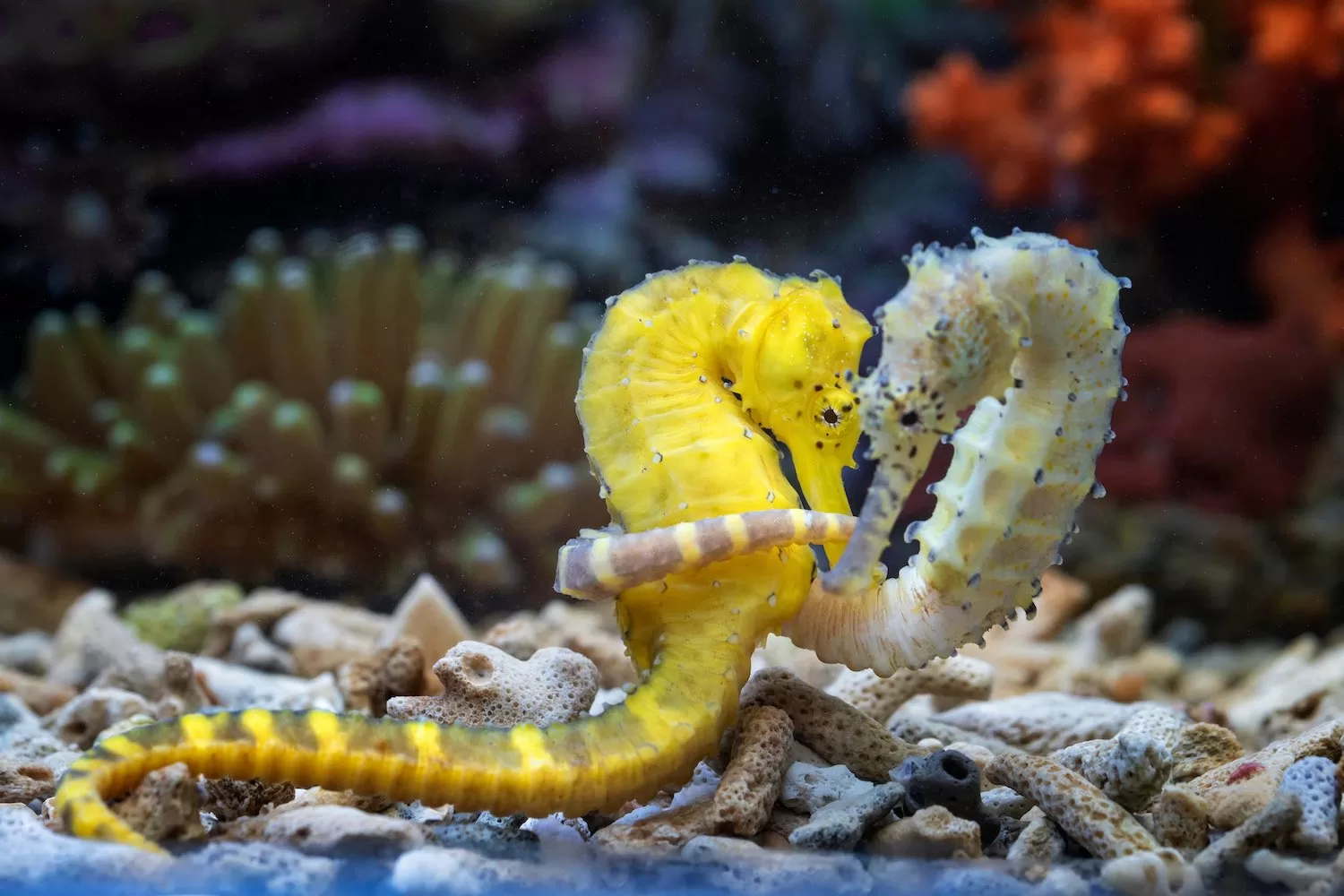
Seahorses and their Holdfast
A Seahorse holdfast is a specific location that a Seahorse finds on a coral reef that becomes their ‘safe location’. Seahorses will return to this anchor of safety, never straying more than a few meters from it, which is especially important when there are strong currents.
Seahorses can holdfast with their prehensile tails to prevent themselves from being swept away from their home.
One of the most easily recognizable fish we see in the ocean, there are currently 46 known different species of Seahorse or Hippocampus as they are known in Latin.
‘Hippo’ means Horse and ‘kampos’ means sea monster or sea animal.
Most Common Species of Seahorse
- Common Seahorse (Hippocampus hippocampus)
- Dwarf Seahorse (Hippocampus zosterae)
- Pacific Seahorse (Hippocampus ingens)
- Hedgehog Seahorse (Hippocampus spinosissimus)
- Lined Seahorse (Hippocampus erectus)
- Pot-Bellied Seahorse (Hippocampus abdominalis)
- Big-Belly Seahorse (Hippocampus abdominalis)
- Yellow Seahorse (Hippocampus kuda)
- Thorny Seahorse (Hippocampus histrix)
- Tiger Tail Seahorse (Hippocampus comes)
Each species of seahorse has its own unique physical characteristics and can be found in different regions and oceans around the world.
Seahorse Species & Ecological Importance
As predators, they feed on small crustaceans and other invertebrates, helping to control their populations. At the same time, Seahorses are also preyed upon by a variety of larger animals including birds, fish and crabs, which helps to maintain a balance in the food chain.
Seahorses also have an important role to play in maintaining the health of coral reefs. By anchoring themselves to the coral, Seahorses help to protect the delicate structure from damage caused by waves and currents.
Seahorses also feed on algae and other small organisms that can overpower and damage corals if left unchecked.
Although Seahorses may not be a keystone species such as sharks or in the same way corals are, they are still an ecologically important species and an important indicator of how healthy the ecosystem is.
This is because Seahorses are sensitive to changes in water quality and other environmental factors. Declines in Seahorse populations can serve as an early warning sign of broader ecological problems.
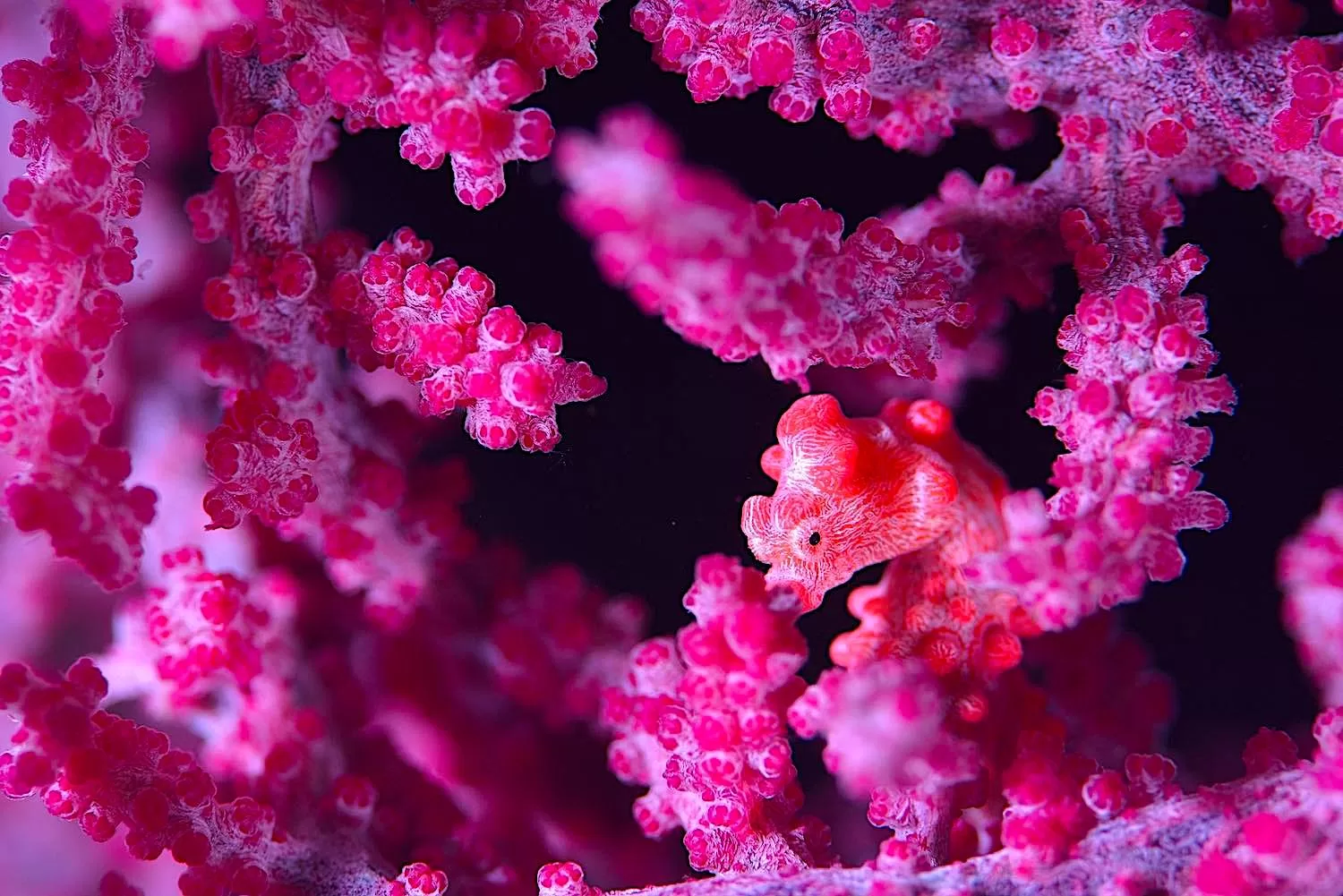
Monitoring Seahorses & Health of Marine Ecosystems
By monitoring Seahorse populations, researchers can gain valuable insights into the health of marine ecosystems, and if necessary, take action to protect them.
Seahorses face many of the same threats that all fish in the ocean face, but because they are more sensitive to those changes, monitoring Seahorses gives added importance.
If you are passionate about marine life and the fragile ecosystems that they live in, then the Seahorse ecology and monitoring course will help you broaden your knowledge and understanding of these unique animals.
Enrolling on this course will help you develop a better understanding of the challenging future coral reefs are facing.
The goals of the Seahorse ecology and monitoring course are to increase knowledge and awareness of Seahorses and give citizen scientists the tools they need to contribute to their conservation.
Improve Scientific Knowledge & Understanding of Seahorses
You will learn how to monitor Seahorses gathering and uploading ecological data and measuring size such as head, snout and torso and length and any other observations to citizen science sites such as to iSeahorse.com and innaturalist.com
You will also learn the reef survey techniques we use to survey Seahorses.
There are various criteria that you will record including size, sex, depth, water temperature, time of day and behavior.
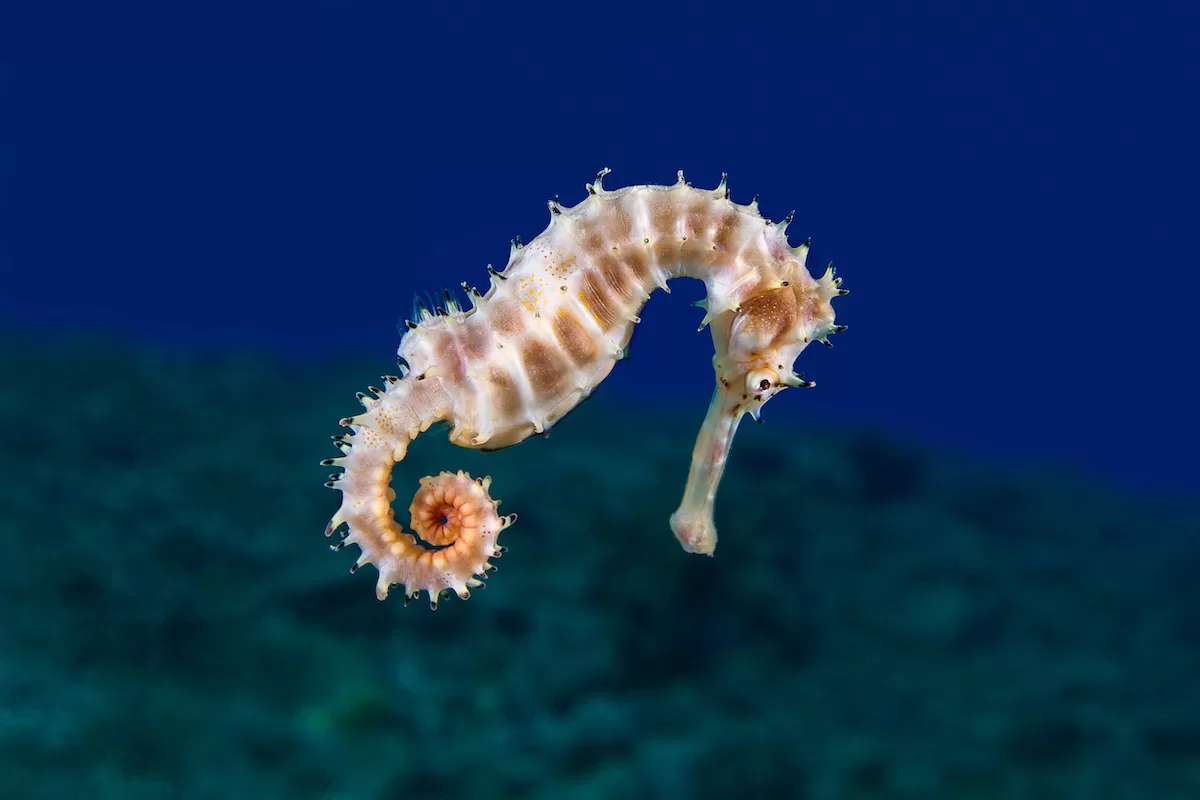
How to identify a Seahorse
The Seahorse ecology and monitoring course also teaches students Seahorse Ecology and how to identify if Seahorses are Spiny or Smooth and identifying different species of Seahorses that we see in the Indo Pacific and around the tropical warm ocean surrounding Koh Tao.
To enroll on the Seahorse ecology and monitoring course an individual must have first completed the EMP Invertebrates presentation and survey dive.
The Ecological Monitoring Program is at the center of the Conservation Diver training, education and research program, and as such this course is a prerequisite for many of the other courses offered by Conservation Diver.
The EMP course provides scuba divers with hands on experience that can be applied to future academic or professional pursuits.
Completing this course is a rewarding and enriching experience for everyone, regardless of whether you are pursuing a career in this field or simply have a personal interest in marine life and the oceans.
Those who master the skills & knowledge on the EMP course are encouraged to go on to achieve the Advanced Ecological Program certification.
Professional Development as a Coral Reef Researcher
The Advanced Ecological Monitoring Program certification is awarded to students who show exceptional research skills.
An individual must already be an EMP diver and have completed Conservation Diver Specialty training courses in Coral Taxonomy & Identification, Coral Disease & Compromised Health and 3 other monitoring courses.
The Seahorse Ecology & Monitoring course is one of the Conservation Diver Specialty courses that can be credited towards the Advanced Ecological Monitoring Program.
Reef researchers and students all round the world use similar programs to collect data meaning the Advanced Ecological Monitoring Program will help with your professional aspirations too.
By increasing awareness and involvement, we can decrease our impacts on coral reefs and provide solutions to protecting and restoring the reefs around the globe and help to make a difference.
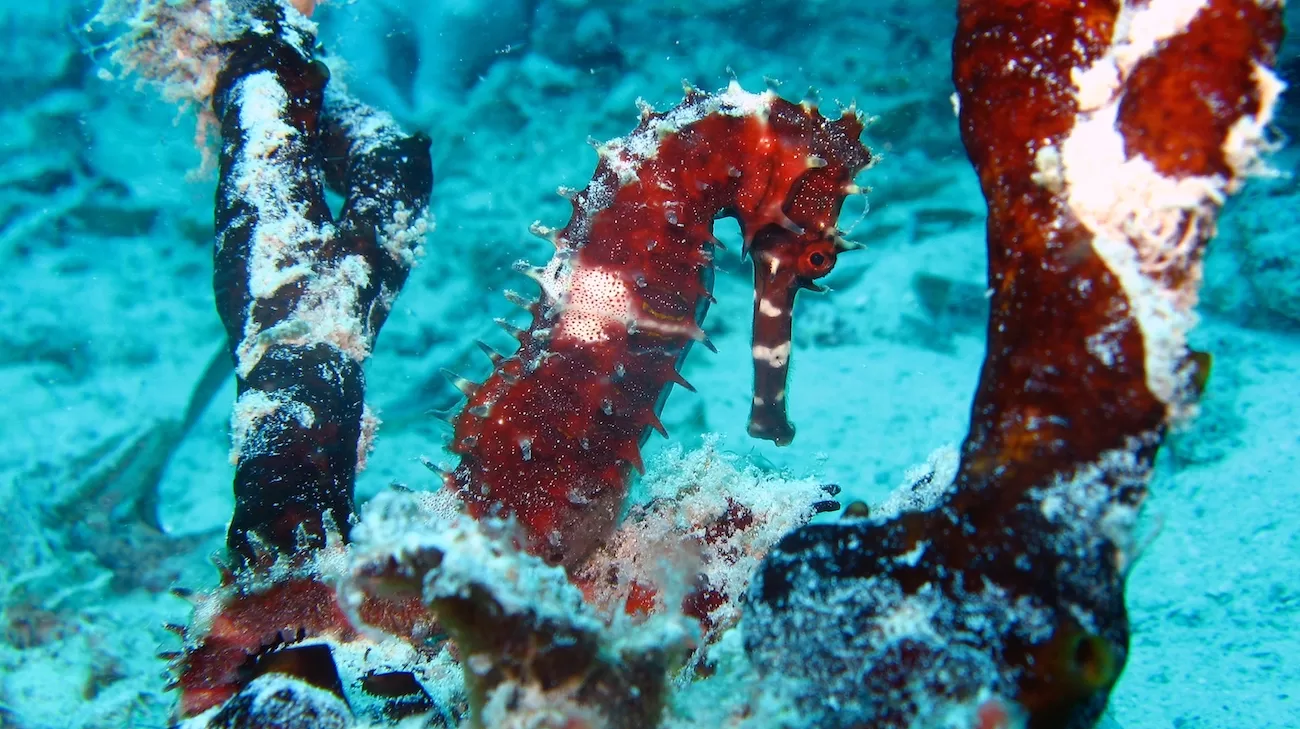
Advanced Ecological Monitoring Program
Most successful restoration projects have been achieved by small groups and local communities, rather than governments or policy makers, and Black Turtle Dive is continuing this tradition, doing as much as we can to protect the local environment on Koh Tao.
After completing this course, students will know how to perform the reef research methods of the Ecological Monitoring Program and can continue to help with data collection.
You will gain knowledge about coral reefs and their inhabitants. Students will learn how to identify indicator fish, invertebrate species and substrate types and gain experience working with equipment underwater. You will also practice buoyancy and navigation skills.
Once you have successfully completed the training you can assist on our monthly EMP’s, and participate in EMP’s in other areas of the world with our network of Conservation Diver Centers.
BOOK NOW 6,000 baht
Conservation Diver Seahorse Ecology & Monitoring course
- 1 day program
- 1 Seahorse training dive
- Seahorse Ecology & Monitoring course manual
- Rental of all scuba equipment
- FREE use of Dive Computer
- Log book
- Black Turtle Dive Customer (and environmental) promise.
Enroll on the Conservation Diver Seahorse Ecology & Monitoring course as a certified scuba diver or a snorkeler.
- Be 12 years of age or older
- Be a competent swimmer if performing the course snorkeling
- Be certified as an Advanced diver under a leading diving organization (PADI, SSI, RAID, etc.) or an Open Water diver who has satisfactorily completed a buoyancy assessment with a Conservation Diver Instructor or completed a buoyancy specialty course with a leading certification organization.
- Have completed the EMP Invertebrates Instructor led presentation and completed the EMP Invertebrates survey
All Conservation Diver Seahorse Ecology & Monitoring course divers must demonstrate proper diving ability at an advanced level and be proficient in buoyancy and self-awareness.
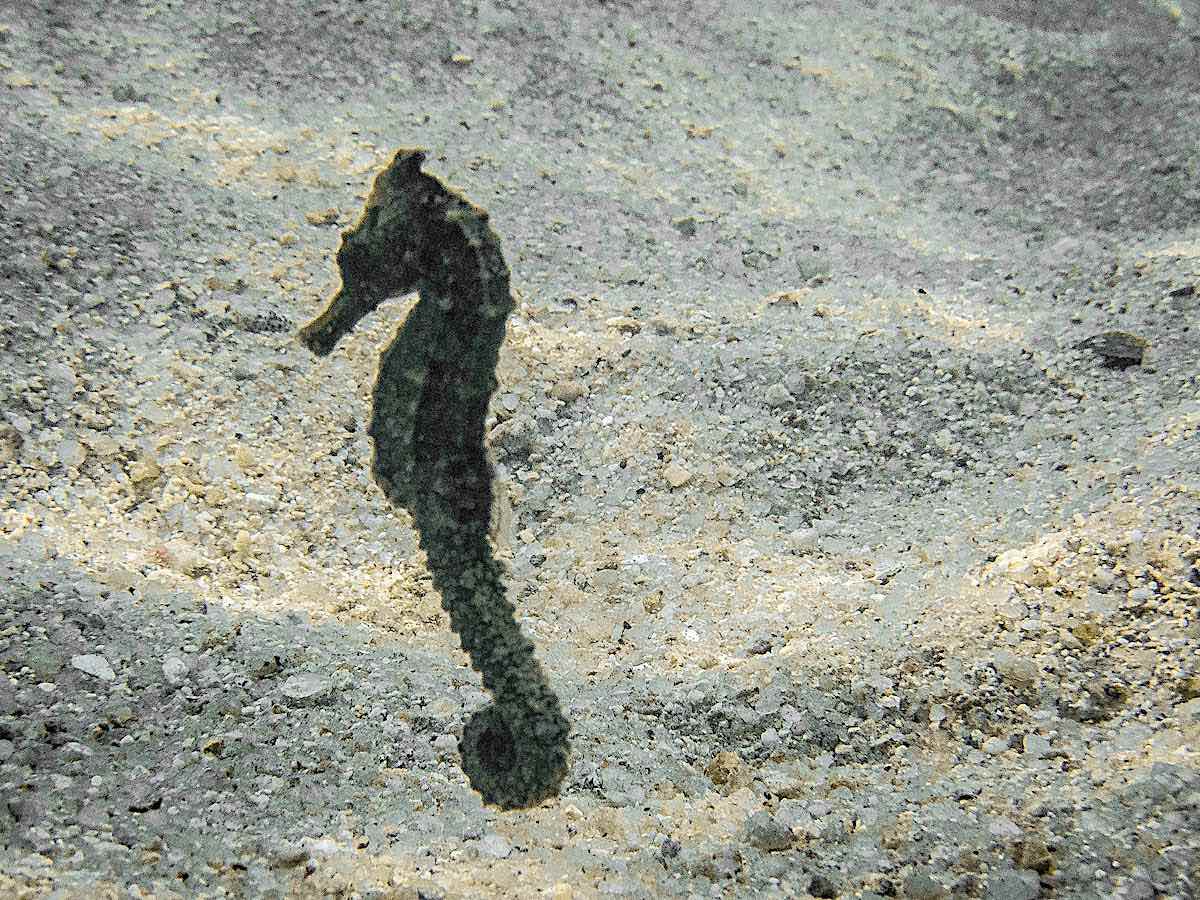
Seahorse Ecology & Monitoring Course Schedule
- Complete the Seahorse Ecology and Monitoring e-learning course
- Complete the Seahorse Ecology and Monitoring Exam and score at least 80%
- Attend the Instructor led presentation on Seahorse Ecology and Monitoring
- Complete Identification quiz using dichotomous key and Seahorse photos
- Attend the practical briefing prior to the survey dive
- Complete 1 Seahorse survey dive (in 2 different roles)
- Enter GPS into Google Earth
- Enter sightings and data into iSeahorse.org and other relevant databases
Seahorse Ecology & Monitoring Course Information
- Learn about Seahorse ecology and identification and understand the global and local threats to Seahorse populations
- You will learn the diagnostic features for identifying Seahorses and be able to identify the most common local species of Seahorse
- You will learn how to conduct a survey for Seahorse using the roving diver and transect survey methods
- Practice a Seahorse survey by completing at least two of the main tasks (surveying along the line, controlling the GPS raft, and keeping track of dive activity timing)
- Be familiar with the iSeahorse.org website and how to enter sightings data into the global database.
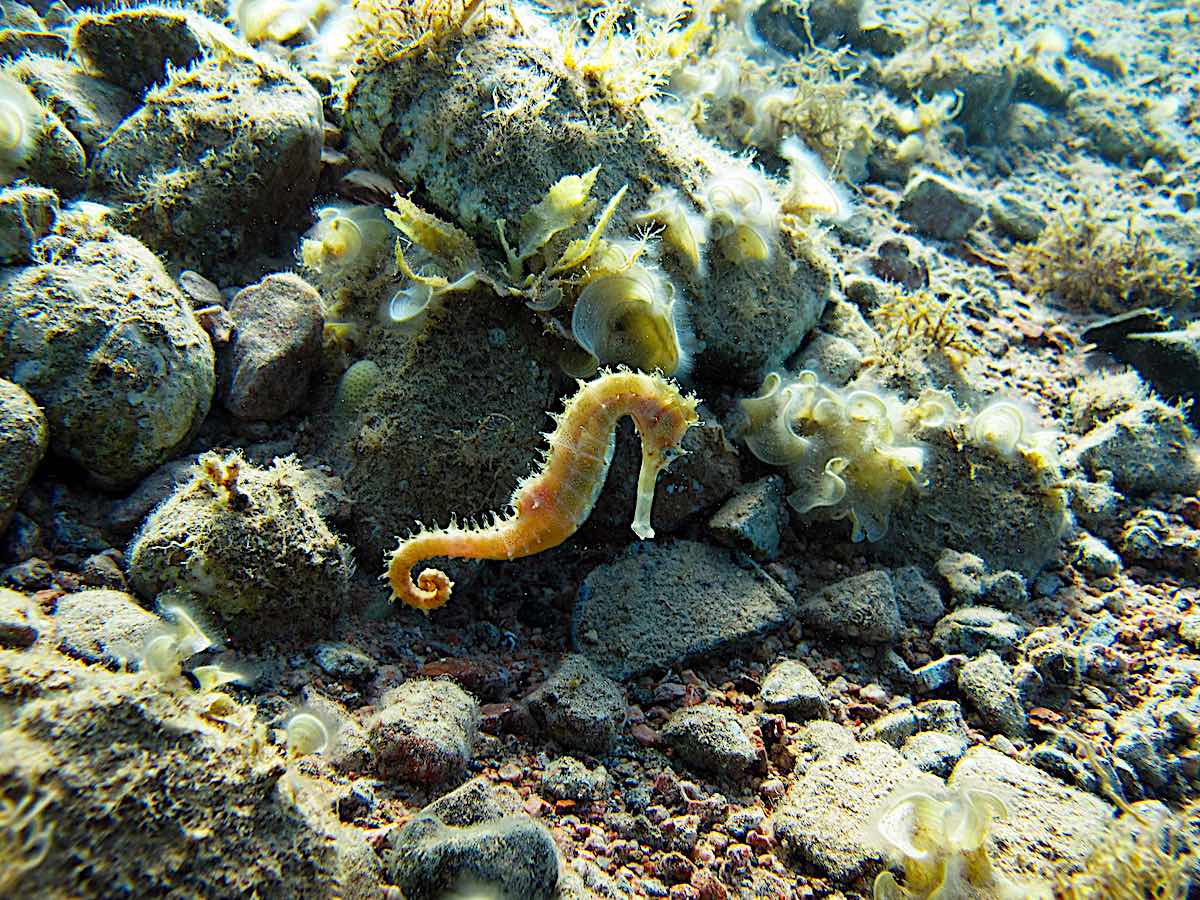
Knowledge Development Section
The knowledge development section of the Seahorse Ecology & Monitoring course is divided between independent study (E-learning) and a classroom knowledge development presentation and briefings, led by one of our Conservation Diver Instructors.
E-learning covers ten sections and the following subjects:
Course Standards & Requirements
- Prerequisites
- Standards
- Requirements
An Introduction to Seahorses
Evolution of Seahorses
- Life History of Seahorses
- The Syngnathiformes of Order of Fish
- The Syngathidae Family
Seahorse Ecology
- Diet & Feeding behaviour
- Trophic level
- Reproduction
- Ecological Niche
- Holdfasts
- Geographical distribution
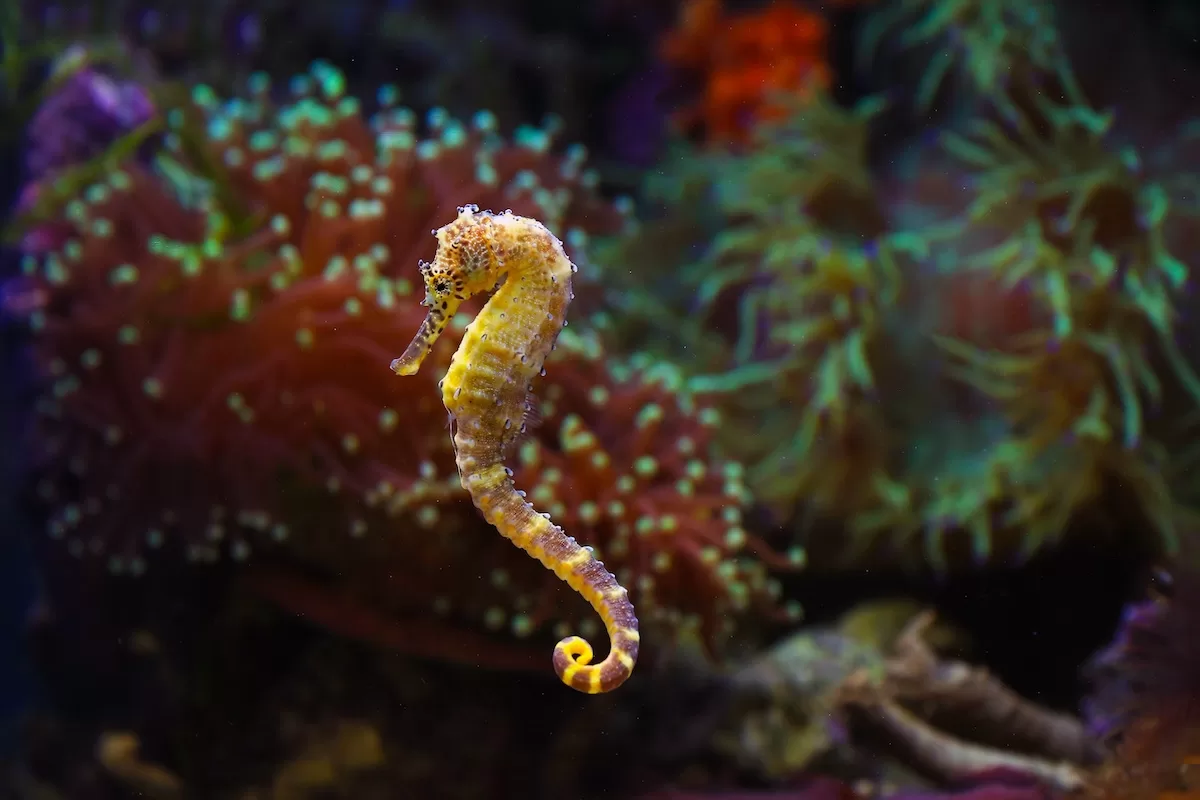
Seahorse Anatomy & Identification
- Spiny or Smooth
- Seahorse Anatomy
- Male & Female
- Using Dichotomous Keys
Seahorses in Koh Tao, Thailand
Seahorse Species of the Indo Pacific
- Smooth Species of the Indo Pacific
- Spiny Species of the Indo Pacific
- Other notable species of the Indo -Pacific
Seahorse Species of the Americas
- Species of the Americas: Pacific Ocean
- Species of the Americas: Atlantic Ocean
Species of the Eastern Atlantic
- Species of the Eastern Atlantic
Threats to Seahorses
- Seahorses & CITES
- Fishing Pressures
- Habitat Destruction
- Invasive Species
- Climate Change
Monitoring Seahorse Populations
- Belt Transect Survey
- Roving Diver Survey
- Modified Belt Transect
- Estimated Distances during surveys
- Collecting Data: Ecological Data
- Collecting Date: Seahorse Sightings
- Submitting Data
We recommend that you complete all independent eLearning before you start the Seahorse Ecology and Monitoring course.
However, if you are signing up late, or have been unable to complete the e-learning prior to arrival, we will ensure you complete the prerequisite study in a manner that supports the water skills.
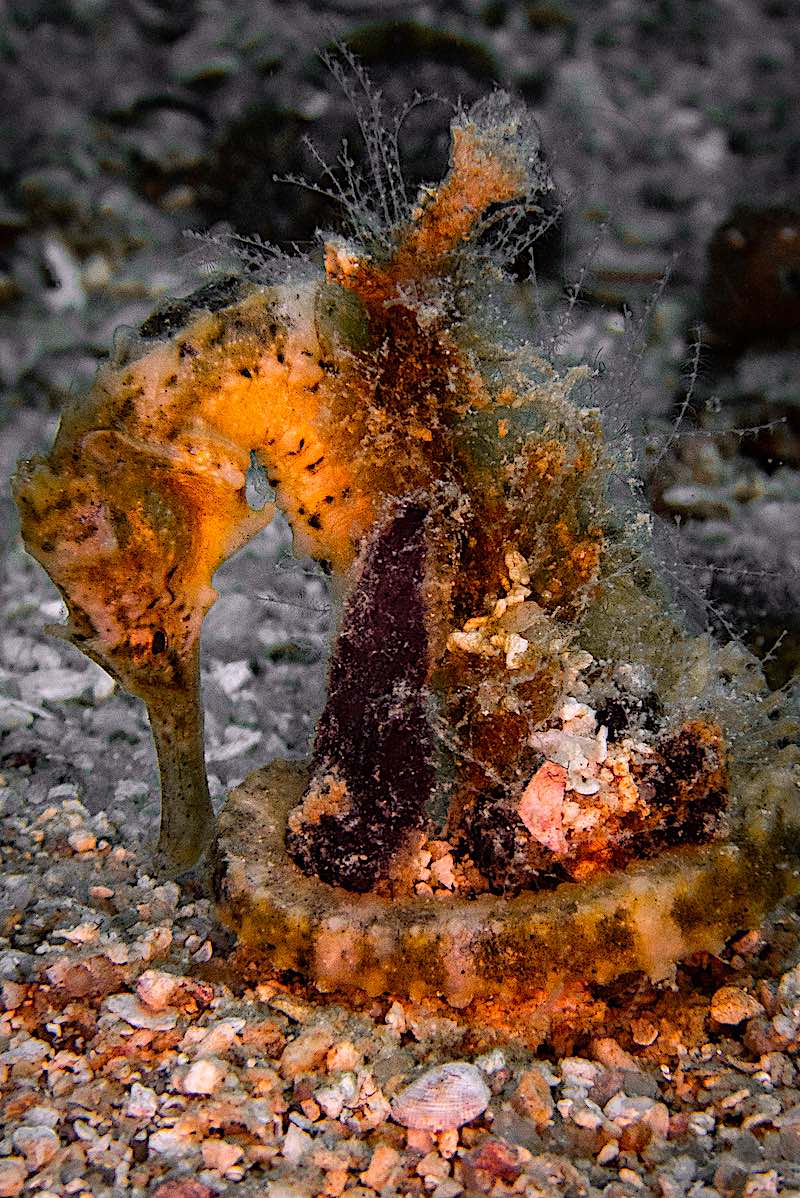
Knowledge Development Presentation & Classroom
- Taxonomy
- Evolution
- The Syngnathiformes Order
- Syngnathidae family & distribution
- Diet & feeding
- Predators
- Reproduction
- Courtships
- Ecological importance
- Habitats
- Global status
- Monitoring
- Data Collection
- Survey Techniques
- Seahorse Anatomy
- Spiny, Smooth or Pigmy Seahorses
- Seahorse Identification
Water Skills Development & In-Water Workshops
- Buoyancy assessment
- Conduct 1 Seahorse survey in 2 different roles
Complete our Seahorse Ecology and Monitoring Course
- Complete all e-Learning modules
- Attend the Instructor led Seahorse Ecology & Monitoring knowledge development presentation
- Complete ID quiz using dichotomous key and Seahorse photos
- Complete 1 Seahorse survey dives (in 2 different roles)
- Enter GPS data into Google Earth Enter sightings and data into the iSeahorse.org and other relevant databases (if Seahorse was observed)
BOOK NOW 6,000 baht
Thailand Seahorse Ecology & Monitoring Course
Black Turtle Dive takes its customer promise very seriously and we wish to pass on our passion for providing only the highest quality of training and service to all our customers.
The marine conservation program at Black Turtle Dive was launched in 2022, having evolved out of Eco Koh Tao, one of the longest running environmental organisations on the island.
Eco Koh Tao was founded by Nathan Cook, a master of Marine Science from Southern Cross University, Australia and Matt Bolton, a PADI Course Director who first brought Reef Check to the island in 2007 and founded Black Turtle Dive.
Eco Koh Tao planned and developed Junkyard Reef, Koh Tao’s first and arguably most successful artificial dive sites. This work started in 2006 and continues to this day and Junkyard Reef hosts thousands of Open Water training dives every year, taking pressure off existing natural dive sites around Koh Tao.
Eco Koh Tao has also worked hard over the years monitoring reef health and being involved in multiple restoration projects. This work included being an integral part of the Save Koh Tao organization that spearheaded Buoyancy World, an island wide initiative to develop a second artificial reef in 2009.
Artificial Underwater Structures on Koh Tao
Black Turtle Conservation symbolises the unification of Koh Tao’s two original ocean researchers, Nathan and Chad Scott. Chad founded Conservation Diver on Koh Tao in 2014, following 6 years of development work at his NHRCP program.
Conservation Diver is now a world leader in marine conservation education and has certified thousands of ocean enthusiasts over the past decade.
Eco Koh Tao and NHRCP worked towards mutual goals for many years, however, it is with the Black Turtle Dive program where finally their deep local knowledge and global conservation vision has been combined to form what we feel is the best Reef Ecology And Conservation Training program (REACT).
Conservation Diver has a global network extending across 11 locations, with 50+ instructors, teaching over 35 different marine science courses, bound together in their mission to train the next generation of marine conservationists.
Black Turtle Conservation are proud to be part of this shared vision. By working together in this way, we are able to benefit from data collaboration and the vast knowledge shared between a large groups of experts in varying fields.
No other network in the world exists that connects conservation programs in such a way, which gives our students the benefit of being part of a movement of research and conservation much bigger than one single program of work.
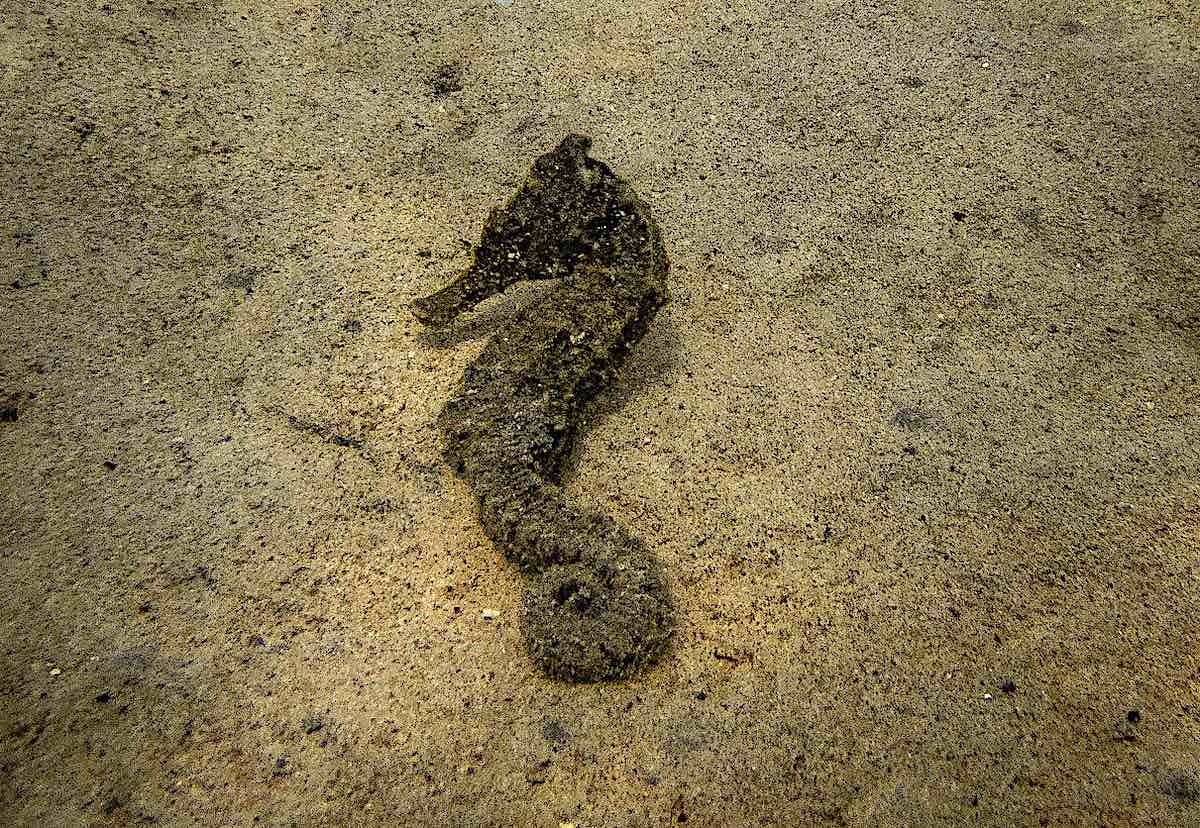
Seahorse Ecology and Monitoring Course Schedule
The Seahorse Ecology is scheduled over 1 day:
Day 1
- Orientation
- Seahorse Ecology & Monitoring knowledge development presentation
- Complete ID quiz using dichotomous key and Seahorse photo
- LUNCH
- Buoyancy check
- Complete the roving diver & transect survey method
- Complete at least two of the main tasks – surveying along the line, controlling the GPS raft, keeping track of dive activity timing etc.
- Enter any sightings data into the iSeahorse.org website
Seahorse Ecology & Monitoring Course Information
Let us take a look at the Seahorse Ecology & Monitoring course in more detail.
Orientation & Knowledge Development
As soon as you sign up we will send you your Seahorse Ecology & Monitoring course e-learning manual.
Once you have redeemed your access code you can start working your way through the e-learning and we recommend you complete the e-learning prior to the practical element of the course.
You will start the Seahorse Ecology & Monitoring course with an Orientation.
This includes completing all required paperwork; Release of Liability/Assumption of Risk/ Non-agency Disclosure & Acknowledgment Form, Student survey, Student Responsibilities agreement, Scientific Diving Acknowledgment Agreement, Standard Safe Diving Practices Statement of Understanding and Medical Statement (RSTC Medical form).
Seahorse Ecology E-learning
As you can see from the schedule above the Seahorse Ecology & Monitoring course e-learning knowledge development comprises of 10 modules.
Each module has a corresponding e-learning section and ideally this needs to be completed before the Instructor led presentation.
Our Instructor led knowledge development session is scheduled to precede in-water skill development and survey training dives and will cover and elaborate on the 10 sections you completed during the e-learning.
Additional dive and theory reviews and feedback are scheduled outside of the main teaching schedule, when required with each individual candidate.
You will be given a Seahorse Identification quiz during the classroom presentation, prior to the survey dive.
Water Skill Development Workshops
Buoyancy Assessment for Scientific Diving
Prior to all Conservation Diver training courses candidates must satisfactorily complete a buoyancy assessment with a Conservation Diver Instructor.
This includes being able to swim slowly with legs elevated to avoid damaging the reef with the students head in the down position.
You must be able to record data on an underwater slate whilst on the reef, be able to maintain good buoyancy and not touch the reef with any part of your body or equipment.
You should also be able to maneuver easily in a manner that avoids any disturbance of the reef.
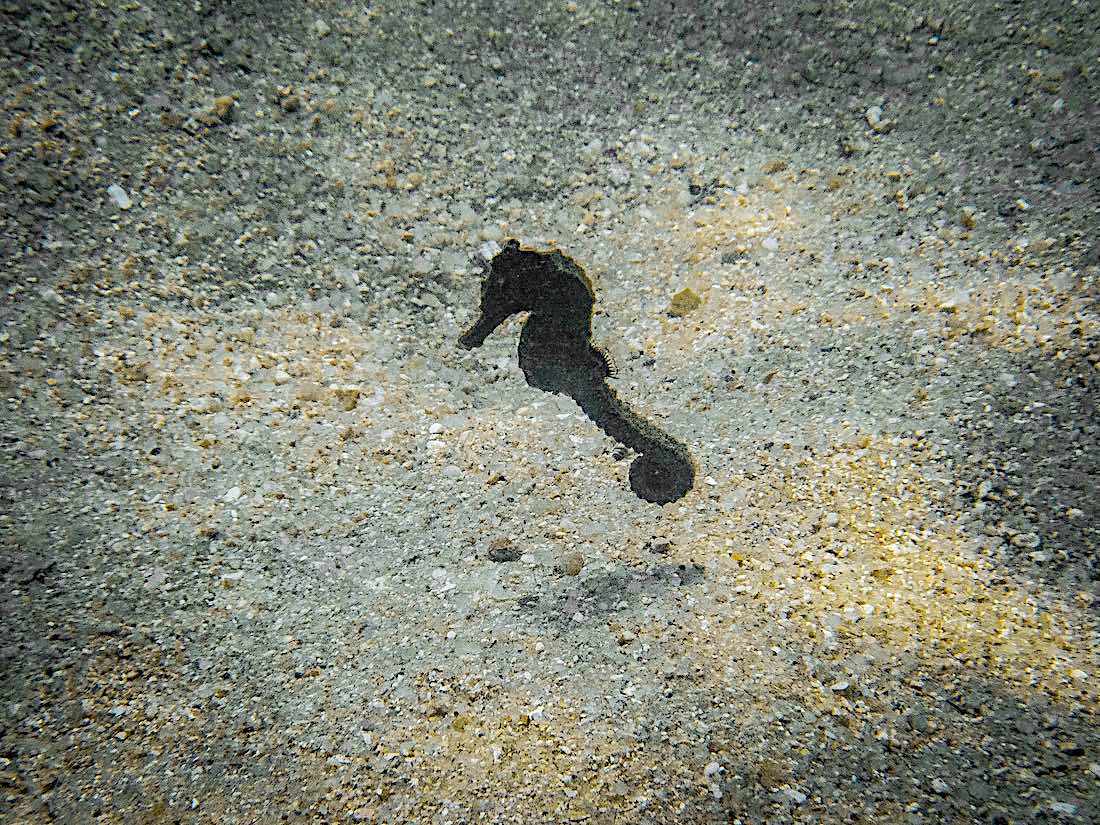
Seahorse Ecology & Monitoring Survey Techniques
The first survey we use to monitor Seahorses is the roving diver survey. In this survey we will use a U Shaped pattern rather than laying a transect line down.
With this roving diver survey, each diver surveys 1 meter either side as they navigate a U Shaped pattern swimming slowly.
In this case we could use a GPS, mounted on a float attached to a reel to allow us to accurately measure exactly what area we surveyed. Alternatively we could use kick cycles or dive time.
Rover Diving Survey
The second survey is where we use a line and a team of divers and the line is merely to keep all divers together.
Each diver stays approximately 2 meters apart (distant can vary) and they observe a region of 1 meter either side of their body.
Divers are arranged in a V formation so that it is easier for the leader (in the center) to control the teams position and movement.
Each surveyor observes data within an imaginary belt, also known as a run and we can choose a depth gradient to follow. Alternatively we can use a specific bearing.
The length (distance) of the survey needed in order to quantify the area covered can be achieved by:
- Towing a GPS on a raft at the surface
- Bringing and starting the survey at known points, or taking a GPS position at the start and ending points
- Time the survey and factoring together with average distance travelled per minute
- Counting kick cycles
The goal of this survey is to cover as much area as possible, whilst still being able to quantify the area observed.
When you conduct a Seahorse survey there is a list of information and data we need to collect.
- Calculate the length of the Seahorse torso
- Note number of facial spines
- Note specific ecological data such as depth, time, location, water temp, substrate type, sex, behaviour
- Record holdfast
Your instructor will include all technical requirements in the pre dive briefing.
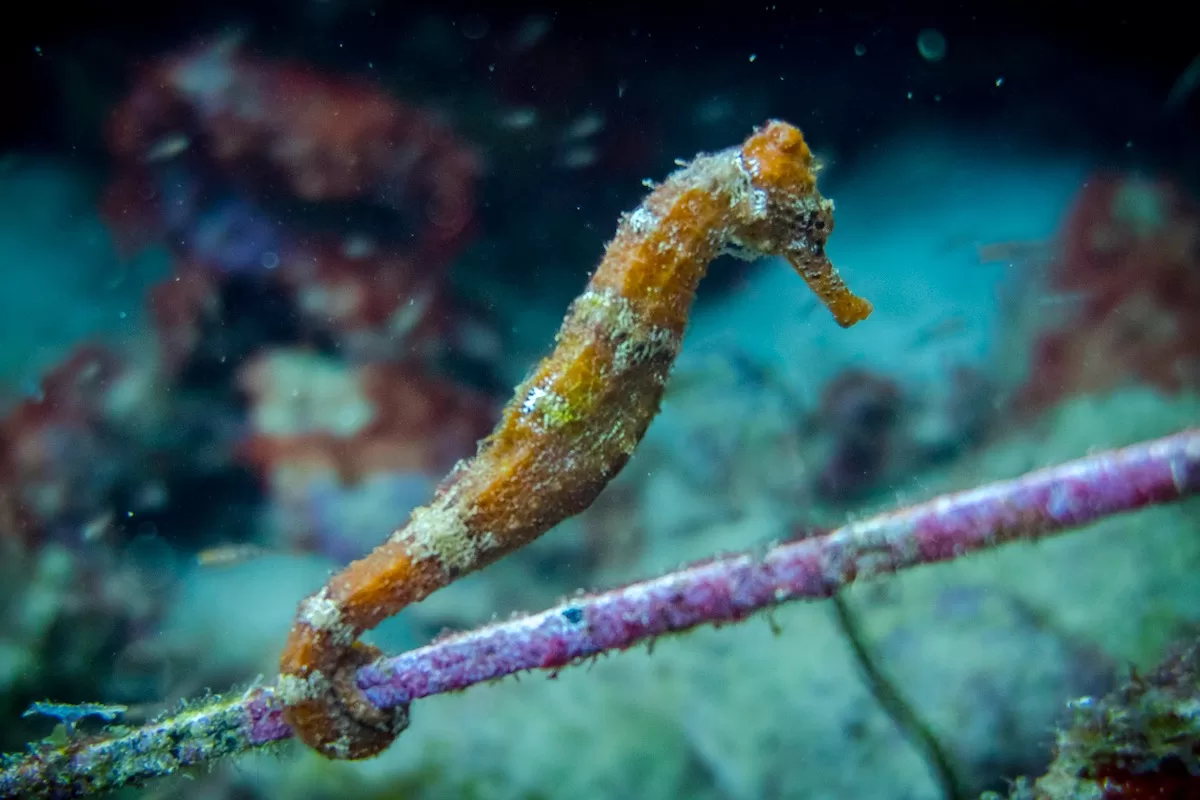
BOOK NOW 6,000 baht
Importance of Monitoring Seahorse Populations
Conservation
Many species of seahorses are endangered or threatened due to overfishing, habitat loss, and many other factors. Monitoring their populations helps to determine the health of these species and can inform global conservation efforts to help protect them.
Ecosystem health
Seahorses are an important part of marine ecosystems, and their decline can have cascading effects on many other species. Monitoring their populations can help to identify changes in the ecosystem and potential issues that need to be addressed.
Sustainable fishing
Seahorses are often caught as bycatch in fishing nets or targeted for the aquarium trade. Monitoring their populations can help to ensure that fishing practices are sustainable and not causing harm to the seahorse populations.
Scientific research
Seahorses are unique creatures that have adaptations that are of interest to scientists. Monitoring their populations can provide valuable information about their biology and ecology.
Monitoring Seahorse populations is essential for their conservation and for the health of marine ecosystems and by understanding their populations and the threats they face, we can take steps to protect them and ensure their survival for future generations.
Learn all about Seahorses on our 1 day Conservation Diver Seahorse Specialty course on Koh Tao.
Frequently Asked Questions
What is the price of the Seahorse Ecology and Monitoring course?
Seahorse Ecology and Monitoring course costs 6,000 baht per person and includes all equipment, certification, diver insurance, e-learning, manual and a practical Seahorse survey dive.
The price-point for many of our 1 day specialty courses is competitive and provides great value to students who gain a specialized certification in Seahorse survey techniques and monitoring best practices.
What is the minimum age for the Seahorse Ecology and Monitoring course?
Minimum age to sign up for the Seahorse Ecology and Monitoring course is 12 years of age.
However, there are additional prerequisites including an Advanced diver certification and/or Buoyancy assessment and students must have completed the Instructor led presentation and conducted an Invertebrates survey from the EMP course.
What is the Seahorse Ecology and Monitoring course about?
Seahorse Ecology and Monitoring course provides students and researchers with valuable information and insights to help monitor Seahorse populations.
Signing up for the Seahorse Ecology and Monitoring course will broaden students knowledge of Seahorses, surveying and monitoring techniques and provide a better understanding of Seahorse habitats and populations.
How long is the Seahorse Ecology and Monitoring course for?
Seahorse Ecology and Monitoring course can be completed in 1 day as a specialty course and upon successful completion students are awarded the Conservation Diver certification.
Students can complete e-learning before arrival and participate in the Instructor led presentation, followed by a practical in-water dive to conduct a Seahorse survey.
Can you take a Seahorse Monitoring course in Thailand?
As an Official Conservation Diver Training centre, Black Turtle Dive offer students Seahorse Ecology and Monitoring as a 1 day specialty course on Koh Tao island in Thailand.
Black Turtle Dive are part of a global network of Conservation Diver training centers and provide customers with a wide range of 1 day specialty courses in addition to our Seahorse Ecology and Monitoring course.
